
National science academy of Ukraine
National science center "Kharkiv institute of physics and technology"
Institute of high-energy and nuclear physics

National science academy of Ukraine
National science center "Kharkiv institute of physics and technology"
Institute of high-energy and nuclear physics

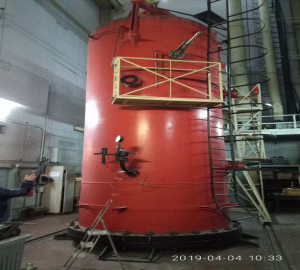

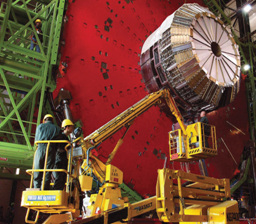

Department Of Nuclear Physics
Head Of Department N.P. Dikiy (Dr. in Phys.-Math. Sc.)
Tel.: +38(057)700-51-60
E-mail: ndikiy@kipt.kharkov.ua
The Department of Nuclear Physics was established in 1950 for solving fundamental and applied problems in nuclear physics. Since this time the research workers of the department have carried out investigations in more than 10 different scientific directions. Scientific production of the department is represented in a great number of publications. During last 5 years over 155 scientific papers were published and 40 patents for invention were obtained. At present time the department staff consists of 1 Dr. in Phys.-Mat. Sci, 6 Ph.D in Phys.-Mat.Sci, 1 Ph.D. in Eng. Sci.), 1 Ph.D in Biol.Sci.
Main directions of research activity
1. Studies on the M1-resonance.
The most complete information on the spin and isospin dependence of nuclear forces is obtained from the M1-transitions. The magnetic dipole M1-transitions provide unique opportunities for studying the meson exchange currents in nuclei as the meson currents do not make a contribution to electric, quadrupole and other transitions. In the real nuclei the M1-power is distributed in the adjacent states and this phenomenon permits to study the relation between the single-particle motion and the collective motion. For the sd-shell nuclei a role of collective motion is insignificant, therefore in these nuclei the magnetic dipole resonance (MDR) is clearly revealed. It has been established that the main mechanism responsible for the MDR excitation is related to the transitions between spin-orbit partners. Due to the study of the electron and quantum scattering the important experimental data on the MDR state in the sd-shell paired- paired nuclei were accumulated. The data on the unpaired-unpaired nuclei(22N, 26Al, 30P) were obtained only in the KIPT [1] using the radiation proton capture (as the unpaired-unpaired nuclei are unstable).A new phenomenon related to the existence of a triplet pairing between the unpaired neutron and the proton being in the same orbit has been discovered. This phenomenon manifests as the position of the center of MDR in the unpaired-unpaired nuclei, depending on the excitation, is by 3 MeV lower than in the paired-paired (4N) nuclei and by 1.5 MeV lower than in the paired-paired (4N + 2n) nuclei. A model for explaining this phenomenon was proposed and the estimates of the position and total force of MDR in nuclei (having no data) were obtained [2]. To confirm and to advance the modeling of the MDR nature and its excitation mechanisms it is necessary to obtain new experimental data on the position, fine structure and total force of MDR in the nuclei where it has not yet been found [3, 4]. These are unpaired-unpaired nuclei and unpaired nuclei of the 1d2s- and 1f2p- shells.
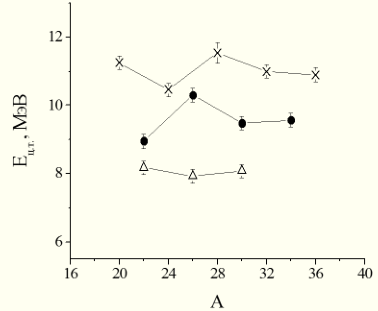 Position of the M1–resonance center as a function of A
in the sd-shell paired nuclei:
⨯ – 4N nucleus, ● – 4N+2n nucleus, △ – 4N+np nucleus
Position of the M1–resonance center as a function of A
in the sd-shell paired nuclei:
⨯ – 4N nucleus, ● – 4N+2n nucleus, △ – 4N+np nucleus
2. Investigations in the nuclear astrophysics field.
The department develops investigations in the field of astrophysics being a new branch of the science one of the directions of which is the study of the processes of producing chemical elements and their isotopes constituting the matter. Interpretations of the p-nuclei propagation in the nature very complicate a question. Experimental and theoretical research into the stellar p-nucleus synthesis is carried out in many scientific centers of Europe, USA and Japan. To study the r- and s-nuclei production one needs the velocities (calculated through the astrophysical S-factor with the use of cross-sections) reached in the (n,γ)-reactions. And for the simulation of p-process the most important reactions are the reactions with low-energy protons (i.e. (р,γ) and (р,n)-reactions) as well as the photonuclear reactions such as (γ,n), (γ,р) and (γ,α) reactions in the near-threshold region. In the Institute of High-Energy and Nuclear Physics (IHENP) a series of measurements on the cross-sections of (р,γ) and (р,n)-reactions on zinc and selenium isotopes has been carried out using the proton beam from the 3 MeV electrostatic accelerator VG-4M. The obtained experimental data will promote the simulation of the stellar synthesis of p-nucleus 74Sе and adjacent nuclei. Under the normal accelerator operation conditions the investigations can be extended to a wider range of mass numbers of atomic nuclei. The integrated yields of (γ,n)-reactions was first measured on the series of isotopes of ruthenium (Ru), palladium (Pd) and tin (Sn) among which 6 p-nuclei are present. In these experiments the bremsstrahlung from the linear electron accelerator (LEA-30) was used. The obtained experimental nuclear data were reported at the international conferences, symposiums, were published and included into the common nuclear database (EXFOR) and specialized nuclear database (KADONIS). The experimental investigations are carried out jointly with the known scientific centers, namely, the Debrecen Institute for Nuclear Research (Hungary), the Joint Institute for Nuclear Astrophysics (USA), and the theoretical analysis is supported by the Department of Nuclear Astrophysics at the Basel University (Switzerland).
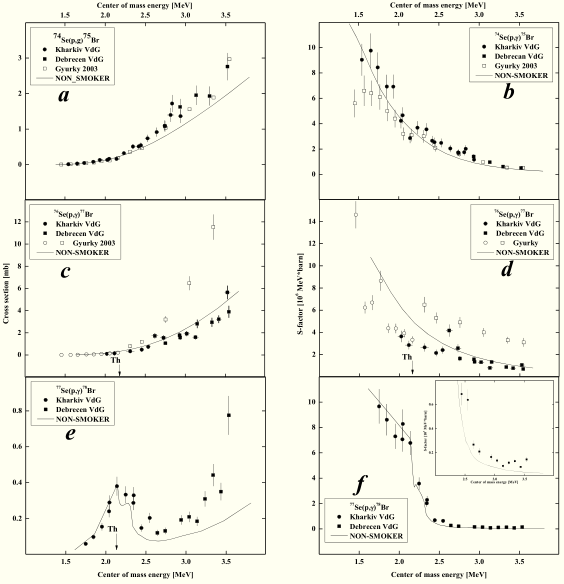 Transverse cross-section (left column) and astrophysical S-factors
(right column) for 74Se(p, γ)75Br reactions (upper row),
76Se(p, γ), 77Br
(middle row) and 77Se(p, γ), 78Br (lower row). Points - experimental
values, curves - statistical predictions of the theory of nuclear
reactions.
Transverse cross-section (left column) and astrophysical S-factors
(right column) for 74Se(p, γ)75Br reactions (upper row),
76Se(p, γ), 77Br
(middle row) and 77Se(p, γ), 78Br (lower row). Points - experimental
values, curves - statistical predictions of the theory of nuclear
reactions.
3. Radiative strength functions.
The urgency in the study of the partial cross-sections (PC) in the reactions of radiation proton capture by the pf-shell nuclei (from scandium isotopes to zirconium isotopes), and of the energy dependence of radiative strength functions (RSF) is determined by several factors. The first of them is a fundamental one. PC and RSF should be used for studying the nuclear structure, nuclear reaction mechanisms, for calculating the full reaction intersections, as well as for testing and checking theoretical modeling approaches. The second factor is an applied one. The experimental data on the cross-sections and RSF constitute a significant part of the nuclear database which is necessary for nuclear power engineering, for investigations into the behavior of structural materials under the radiation influence, for astrophysical research and other practical tasks. The investigations of 45 < А < 90 nuclei are of interest at this time is due to the fact that most of the nuclei of the elements constituting the structural materials are used in the reactor engineering, nuclear power engineering and space technology, and belong just to this group of nuclei. The pf-shell region contains 44 stable nuclei and for most of them the partial cross- sections of the (р, γ)-reaction were measured experimentally on the accelerator ESA-5 at the NSC KIPT in the proton energy range from 1 to 3 MeV. Basing on the cross-section measurement results the experimental radiative strength functions (RSF) were calculated for the end nuclei of the (р, γ)-reaction. Theoretical calculations of partial cross sections and RSF were performed with the help of a computer code TEPEL developed in the NSC KIPT. This code, within the statistical theory of atomic nuclei and Hauser-Feshbach formalism, takes into account various advanced model descriptions of RSF. A comparison between the experimentally measured data and theoretically calculated RSF shows a good coincidence. At present time the experimental measurements of the (р,γ)-reaction cross-sections on some pf-shell nuclei are planned in order to obtain new data, improve previously obtained data as well as to extend the energy range. Experiments will be conducted on the proton accelerator ESA-5 at the NSC KIPT. Theoretical calculations of RSF will be performed using the computer code TEPEL. The obtained experimental data on the cross-sections and theoretical estimates of the energy dependence of RSF in various pf-shells nuclei will be put into the nuclear data base NNDC (Brookhaven, USA).
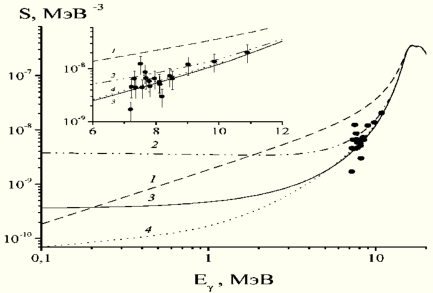 Radiative strength function in the 60Ni nucleus.
Radiative strength function in the 60Ni nucleus.
4. Nuclear experiments for nuclear power engineering and medicine needs.
An important problem for Ukraine is management with the spent nuclear fuel and radioactive waste (RAW) accumulated at the nuclear power plants (NPP), as well as development of effective sorbents for the radionuclide extraction. In this connection, the complex experiments were carried out to study the properties of natural minerals (granite, tuff, zeolite) and metal oxide nanoparticles, which can be used as intermediate barriers for RAW disposal and radionuclide immobilization. Optimum conditions for the gamma-activation with the bremsstrahlung of natural minerals and metal oxide nanoparticles were experimentally optimized with the view to forecast their behavior under the long-term irradiation and to use them as intermediate barriers for RAW disposal. It is shown, that the use of selective natural minerals, enriched with metal oxide nanoparticles, allows one to obtain a high percentage of sorption, for example, for cesium-132 to 99.8%. Using the linear accelerators of the NSC KIPT the photonuclear technologies were developed for producing isotopes Tc-99m, Cu-67 and Pt-195m applied in the radionuclide diagnostics with various carriers, radionuclide therapy and radio-immune analysis. Patents and acts of pre-clinical tests in the isolated tumor cells and organisms of animals were obtained. Jointly with the Kharkiv Institute of Medical Radiology, new methods of obtaining medical drugs containing isotopes (Sm-153, Yb-175, Pm-149) on the basis of nanoparticles of oxides of these elements have been developed for the treatment of metastases in the bones of oncology patients. The photonuclear technology for determining the 44Са/48Са ratio in the hair of children living in the Kharkiv region is developed to define a "risk group" on incidence of osteopenia and osteoporosis. The same technology was applied to study the pathogenesis of odontogenic diseases in the population of the Kharkiv region. In the teeth of patients registered were actinoids such as Ra-226, K-40, Pb-212, etc., indicating a chain on which these radionuclides fall into the human body (air-water-soil-plants-human).
Selected publications in recent years
1. A.S.Kachan, B.A.Nemashkalo, V.E.Storizhko // М1–resonance in the sd-shell nuclei // Yadernaya Fizika. 1989, V. 49. P. 367 (in Russian).
2. A.S.Kachan, I.V.Kurgus, I.S.Kovtunenko, V.M.Mishchtenko, S.N.Utenkov. Structure and total force of the magnetic dipole resonance in the 35 Cl nuclei // Izvestiya RAN. Series: Fizicheskaya, 2011, V.75, No 2. P.239-243 (in Russian).
3. A.S. Kachan // Magnetic dipole resonance in light nuclei. // LAP LAMBERT Academic Publishing. 2015. (2015-03-13)-ISBN-13:978-3-659-32541-0.
4. A.S.Kachan, I.V.Kurguz, V.M.Mishchenko, S.N.Utenkov. Resonance-like structure observed in the 25Mg(p,γ)26Al reaction // Izvestiya RAN.Series: Fizicheskaya, 2017. V. 81. No10. P. 1303- 1307 (in Russian).
5. Ye. Skakun, S. Utenkov, V. Mishchenko, J. Farkas, Zs. Fülöp, Gy. Gyürky, G. G. Kiss, E. Somorjai, T. Rauscher. Сross-sections of low-energy (p,γ) and (p,n)-reactions on selenium isotopes for the astrophysical γ-process. Proceedings of the 3-rd International Conference "Current Problems in Nuclear Physics and Atomic Energy", 7-12 June 1910, p.207.
6. V.M.Bondarenko, A.V.Goncharov, V.I.Sukhostavets, S.N.Utenkov. Cross-section of 90.6 KeV γ–quantum generation from the 48Ti(p,γ)49V reaction in the proton energy range of 0.95-2.8 // EEJP, 2014, 1(4), P.64-68.
7. N.P. Dikiy, A.N. Dovbnya, N.V. Krasnoselsky, Yu.V. Lyashko, E.P. Medvedeva, D.V. Medvedev, V.L. Uvarov, I.D. Fedorets. The use of molybdenum oxide nanoparticles for production of the free isotope Мo-99 // Problems of Atomic Science and Technology. Series: NPI (100).- 2015.- No 6(65). - P.154-156.
8. N.P. Dikiy, Yu.V. Lyashko, E.P. Medvedeva, E.N. Bodnar, A.V. Grushka, N.V. Krasnoselsky, O.N. Paskevich. Kinetics of 153Sm oxabiphor in the blood of cancer patients undergoing complex therapy for bone metastases // Problems of atomic science and technology. Ser.: NPI.- 2015.- №3(64).- P.73-75.
9. E.N. Bodnar, M.P. Dikiy, E.P. Medvedeva Photonuclear production and antitumor effect of radioactive cisplatin (195mPt) // J. Radioanal. Nucl. Chem. – 2015. -vol.305. – P.133-138
10. A.S. Wagh, S.Y. Sayenko, V.A. Shkuropatenko, R.V. Tarasov, M.P. Dikiy, Y.O. Svitlychniy, V.D. Virych, Е.А. Ulybkina. Experimental study on cesium immobilization in struvite structures // J. Hazard. Mater. – 2016. – vol.302. – P.241-249.
International collaboration
Project of IAEA and UKR-22435 "Production of Tc-99m on Electron Accelerators", 2017-2020.